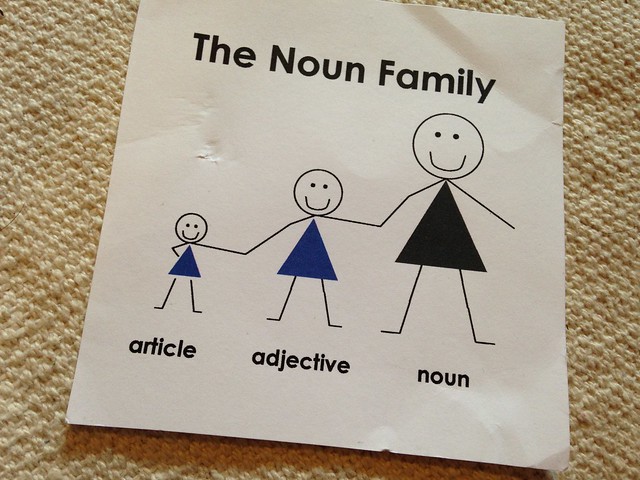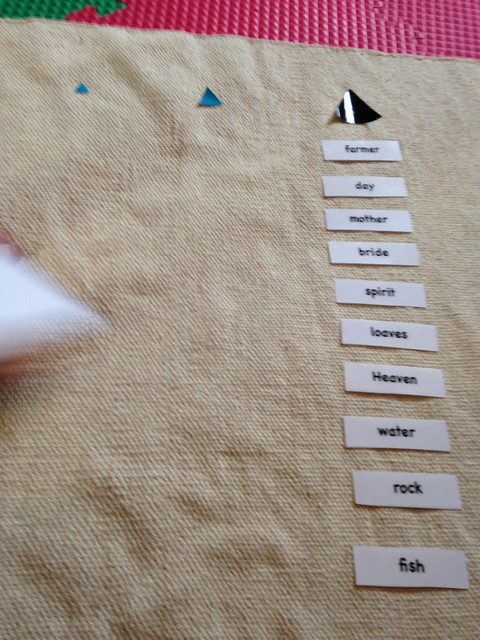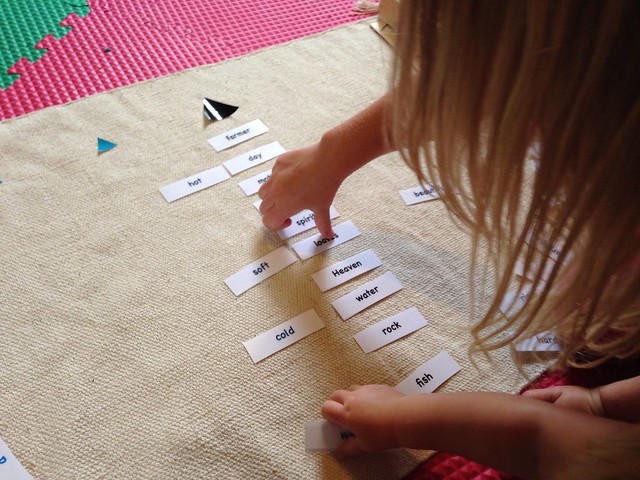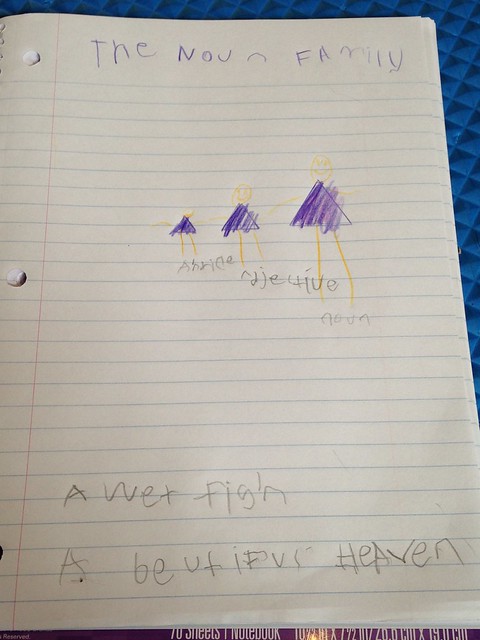This presentation is used as a review presentation for the noun family with a child who has already learned each of these word types. It could also be used as an introduction to adjectives, but you will need to adjust the lesson accordingly. I will always use the detective adjective game for the introduction lesson (although we use buttons instead of triangles).
Target Age: Early Elementary
Grammar symbols or stencil
Word cards for article, adjective, and noun*
Picture of the Noun Family **
Language notebook
Colored pencils
Regular Pencil
Rug
*You can use any selection of word cards here, from a miniature environment, pulled from grammar boxes, or make your own. At this point, my children have been introduced to several sets of language cards and I allow them to choose which set they would like to use. For this lesson, Kylee chose our Life of Jesus Grammar Set (available in my Teachers Pay Teachers store).
**Our image is available free on the Montessori Materials site (under grammar cards and symbols in the far right column).
Setting up The Lesson
After all of the materials have been gathered, I always invite my little student to the lesson before I begin to set up and then I have them watch and we review some of the information as we set up. I didn’t take a good picture of this, so I will do my best to describe it and you will see pieces as I share the presentation steps.
Show the child to picture of the noun family, place the image in the upper right hand corner of the rug (this was cropped out of all my pictures but I promise it was there!).
Review the three members of the noun family (symbol and definition) while placing the corresponding grammar symbols along the top of the rug in the correct order (eventually you will be making three columns).
Leave the pencils and notebooks off to the side.
Ask the child to choose 5-10 cards from the noun pile. Depending on the number of cards in your language set and/or the reading level of your child, you may want to narrow down the options before allowing the child to make their selection.
Lay the noun cards out in a column under the black triangle.
Lesson Presentation/Activity
Select the same number of adjectives (5-10) for the student to describe the nouns. You may allow your student to select their own adjectives, but I find narrowing the choices forces them to think a little harder. For example, Kylee got to the end and only had hard and Heaven left. Those obviously didn’t match, so she needed to make some changes until she found descriptions that made sense.
Add the articles. Review (or discuss) the need for a/an. If a child mis-uses an article, ask them to read their phrase aloud. If they don’t catch the mistake, read their phrase back to them. They can usually catch their own mistake as they understand from the use of spoken language the correct agreement even if they don’t know the specific rules.
Finally, ask the child to read all of their phrases aloud.
Follow Up Activities
In our home, we use a language notebook to record all of our grammar study in one place. Each child has a notebook and when we complete a lesson, I ask them to do a follow up that involves either creating a new page or adding to an existing section. In the Montessori classroom, choices in follow up is fairly standard, but at home I find giving a short, specific, and age-appropriate follow up activity to be more reasonable. I also ask that follow up work be completed immediately following a lesson.
For this lesson, I asked Kylee to create a new page specifically for the noun family. Copying the image and then two of her phrases.
She couldn’t find a black colored pencil and tried to use two or three colors with the purply blue to make it darker, but you can see that didn’t exactly work out!
For a slightly older child, I would ask them to create a certain number of unique phrases in their notebook and may or may not ask them to copy the noun family image. I may also have an older student write the definition of each word type in their own words.
Closing Thoughts
Our approach to Montessori language at home in the elementary years varies from the traditional approach. I have adjusted the majority of lessons and presentations to move away from the extensive filing materials, mostly as a cost savings measure but also to simplify the approach in general. You can view an overview of our complete language approach here.
I am also working on a ebook that will be available soon (I hope…I’m into the editing phase!), that will outline our elementary (1-6th grade) approach more specifically, complete with more sample lessons such as this one, and share ideas and resources for homeschooling parents to develop their own comprehensive language curriculum for the home.
This post is linked to Montessori Monday at Living Montessori Now.






This is great, and I look forward to your book being published